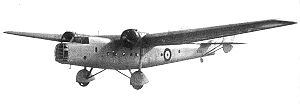Bristol Bombay Video - Picture

|
|
Bristol Bombay
Type 130 Bombay

Picture - Prototype Bombay in flight.
Role: Medium bomber & transport aircraft
Manufacturer: Bristol Aeroplane Company
First flight: 23 June 1935
Introduced: 1939
Retired: 1944
Primary users: Royal Air Force
Royal Australian Air Force
Produced: 1939
Number built: 50
The Bristol Bombay was a British medium bomber and troop transport aircraft flown by the Royal Air Force (RAF) during the Second World War.
Development
The Bristol Bombay was built to Air Ministry Specification C.26/31 for a monoplane aircraft capable of carrying bombs or 24 troops. Bristol's early experience with monoplanes was dismal - both the 1922 racer prototype and the 1927 Bagshot fighter suffered from lack of torsional rigidity in the wings. Based on this experience, Bristol over-engineered the Bombay's wing to include no less than seven spars made from high-strength steel. Not surprisingly, the end product was a very heavy aeroplane.
The prototype Type 130 first flew on 23 June 1935 and an order for 80 was placed as the Bombay. As Bristol's Filton factory was busy building the more urgent Blenheim, the production aircraft were built by Short & Harland of Belfast. However, the complex nature of the Bombay's wing delayed production at Belfast, with the first Bombay not being delivered until 1939, and the last 30 being cancelled.
The Hele-Shaw controllable pitch propellers used on the Bombay were the first product of a Bristol-Rolls-Royce joint venture called Rotol, which would later go on to great success supplying propellers for fighter aircraft.
Operational history
Despite the all-metal, monoplane construction, the Bombay retained some features which were outdated at the time, such as its fixed undercarriage. Although it was outclassed for the European theatre, it saw some service ferrying supplies to the British Expeditionary Force in France in 1940. In June 1940, French pilot Jean-Francois Demozay borrowed an abandoned Bombay to ferry himself and 15 troops from France to England, after which he became an ace with the RAF. Its main service was in the Middle East, replacing the Vickers Type 264 Valentia. The Bombay was capable of dropping 250 lb (110 kg) bombs held on external racks, and was also used to drop 20 lb (20 kg) anti-personnel mines, which were armed and thrown out of the cargo door by hand. The aircraft flew bombing sorties in Abyssinia, Italian Somaliland, Iraq, and Benghazi. Obsolete as a bomber by European standards, the Bombays were predominately used as transports, ferrying supplies and evacuating the wounded. One Bombay crew was credited with flying out 6,000 wounded troops. On 2 May 1941, Bombays of No. 216 Squadron RAF evacuated the Greek Royal Family from Crete to Egypt.
Five Bombay bombers were used by the fledgling SAS in their first official operation in the Middle East, a raid on five forward German aerodromes.
Lieutenant General William Gott, the highest ranking British officer killed in the war, died when the Bombay in which he had hitched a ride was shot down in the Western African Desert. He was about to assume command from General Claude Auchinleck. His death opened the way for General Bernard Montgomery to take over.
Variants
Type 130 : Prototype.
Type 130A Bombay Mk I : Twin-engined medium bomber and troop transport aircraft. Original designation Type 130 Mark II.
Type 137 Proposed civil transport version. Unbuilt
Type 144 Unbuilt development with retractable undercarriage proposed for Specification B.4/34 (won by Handley Page Harrow)
Operators
Australia
Royal Australian Air Force
No. 1 Air Ambulance Unit RAAF
United Kingdom
Royal Air Force
No. 117 Squadron RAF
No. 216 Squadron RAF
No. 267 Squadron RAF
No. 271 Squadron RAF
Specifications (Bombay Mk.I)
Data from The British Bomber since 1914
General characteristics
Crew: 3-4
Capacity: 24 armed troops or 10 stretchers
Length: 69 ft 3 in (21.1 m)
Wingspan: 95 ft 9 in (29.2 m)
Height: 19 ft 11 in (6.1 m)
Wing area: 1,340 ft² (124.5 m²)
Empty weight: 13,800 lb (6,260 kg)
Loaded weight: 20,180 lb (9,173 kg)
Powerplant: 2x— Bristol Pegasus XXII radial engines, 1,010 hp (755 kW) each
Performance
Maximum speed: 167 kn (192 mph, 309 km/h) at 6,500 ft (2,000 m)
Cruise speed: 139 kn (160 mph, 268 km/h) at 10,000 ft (3,050 m)
Range: 1,940 nmi (2,230 mi, 3,560 km) with overload fuel
Service ceiling: 24,850 ft (7,600 m)
Rate of climb: 750 ft/min (3.8 m/s)
Wing loading: 14.9 lb/ft² (72.9 kg/m²)
Power/mass: 0.10 hp/lb (170 W/kg)
Armament
Guns: 2 x— 0.303 in (7.7 mm) Vickers K machine guns in powered nose and tail turrets
Bombs: 2,000 lb (907 kg) as 8 x— 250 lb (113 kg) bombs on underfuselage racks
Related development
Bristol Type 170 Freighter - the first air ferry. (The Bristol Freighter's wing was based on that of the Type 130.)
Comparable aircraft
Handley Page Harrow
Armstrong Whitworth AW.23
Dornier Do 23
Savoia-Marchetti SM.81
Related lists
List of aircraft of the RAF
List of bomber aircraft
Mondey, D. (1982). The Hamyln concise guide to British aircraft of World War II. Hamlyn/Aerospace. ISBN 0-600-34951-9.
Bristol Bombay Pictures
Living Warbirds: The best warbirds DVD series.
Source: WikiPedia